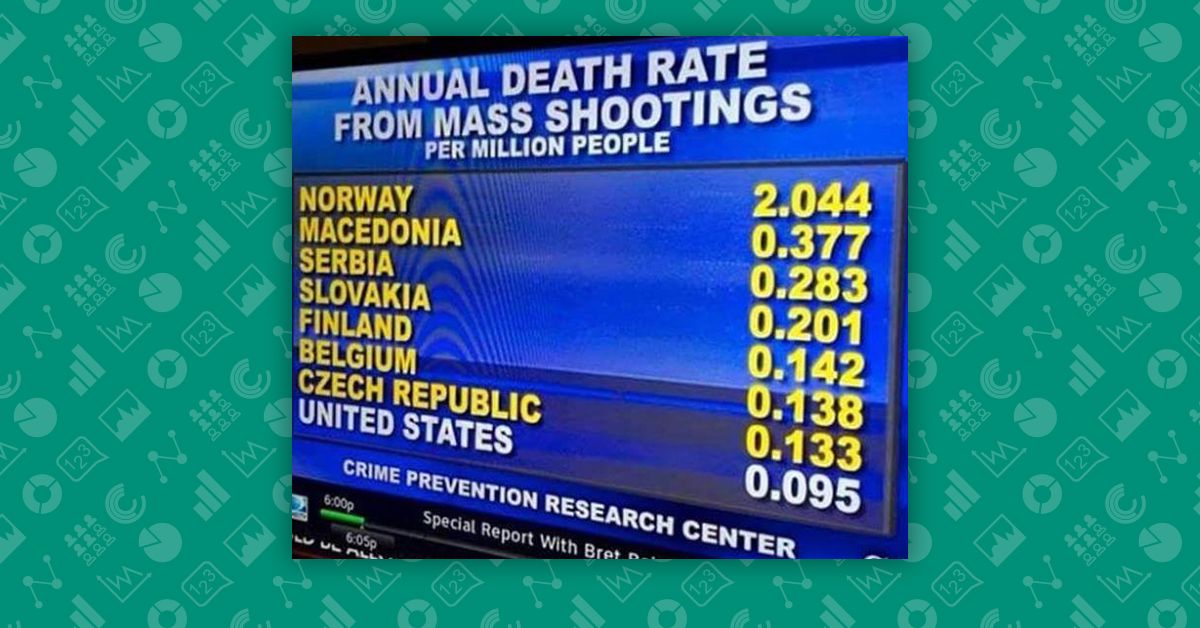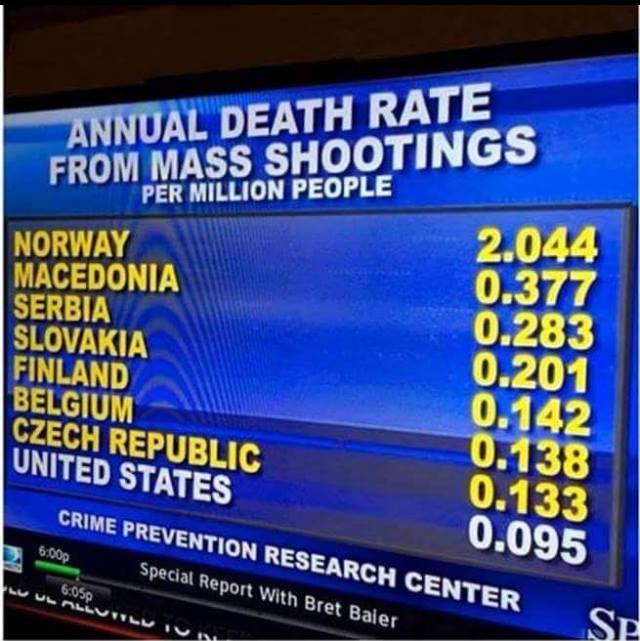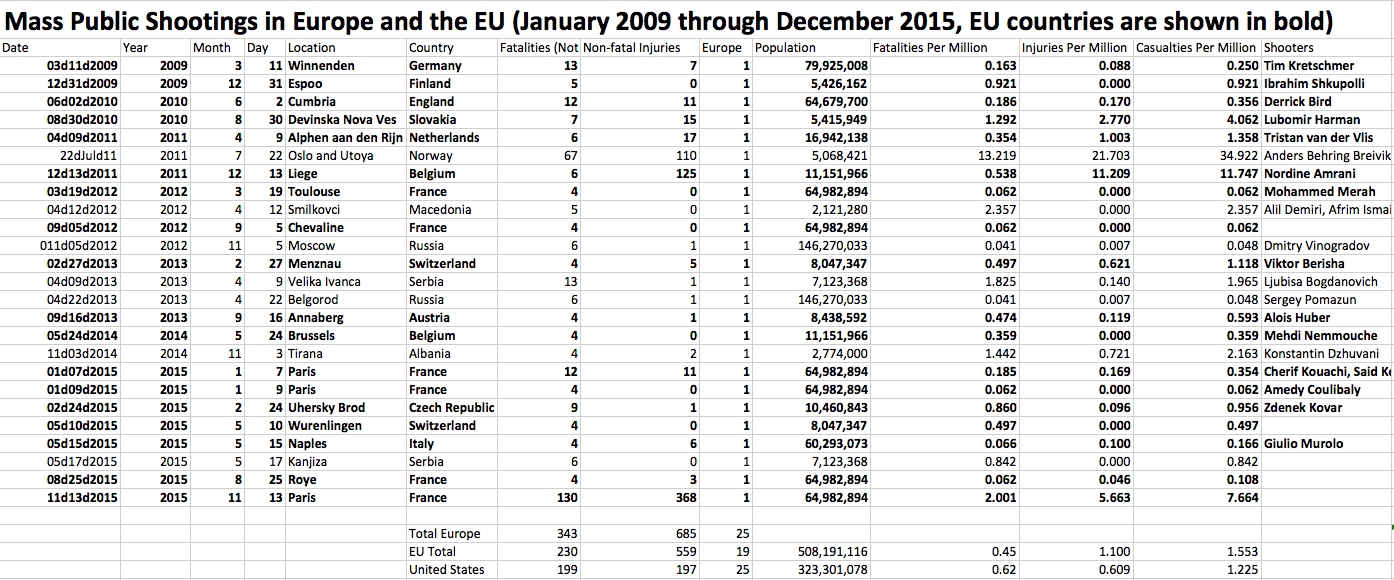In the aftermath of a mass shooting in Parkland, Florida, in which a gunman killed seventeen people in February 2018, a ranking of deaths from mass shootings in various countries re-emerged on social media with the apparent intention of proving that the United States does not have a comparatively serious problem with gun violence.
This image is taken from a December 2015 episode of Bret Baier's Special Report on Fox News. It reappeared in March 2018:
The source of the list is a 2015 article published by the Crime Prevention Research Center (CPRC), a pro-gun rights nonprofit run by economist John Lott. In his research, Lott found that between 2009 and 2015, the number of people killed in a mass shooting in the United States (in relation to the overall population) was lower than it was in several European countries, including Norway, France, Switzerland and Finland.
Our conclusion is that this is accurate based on the CPRC's definition of a mass shooting, but also extremely misleading. It uses inappropriate statistical methods to obscure the reality that mass shootings are very rare in most countries, so that when they do happen they have an outsized statistical effect. Of the countries chosen by Lott for his analysis, the United States is by some distance the most consistent site of mass shootings.
What is a mass shooting?
Counting mass shootings is a notoriously difficult exercise. For one thing, there is no consensus on what counts as a mass shooting, and what doesn't. The FBI, for example, defines a mass shooting as involving the murder of three people. The pro-gun-control nonprofit group Everytown for Gun Safety defines a mass shooting as one in which four people are killed, not including the shooter. Mother Jones, which tracks mass shootings in the United States, defines the phenomenon as "indiscriminate rampages in public places resulting in four or more victims killed by the attacker." The Mass Shootings in America project, run by Stanford University, defines a mass shooting as one involving three or more victims (not including the shooter) but is not limited to fatalities.
These metrics also typically focus on gun violence that is not related to armed robberies or gang activity, and often exclude domestic "family annihilations," instead including only mass shootings that take place in public. They also typically include terrorism-related shootings, a factor that becomes especially important when comparing mass shootings in the United States with those in other countries.
Lott, in his research, defines a mass shooting as involving "four or more people killed in a public place, and not in the course of committing another crime, and not involving struggles over sovereignty."
We will examine Lott's claim on its own terms, while bearing in mind that the figures can shift depending on which definitions and criteria are used.
The CPRC analysis
From 2009 to 2015, there were 199 deaths from 25 mass shootings in the United States, according to Crime Prevention Research Center's downloadable data. If we apply the CPRC criteria to other data sources (Mother Jones and Everytown), this number largely checks out, but there are instances where the difficulty of categorizing mass shootings becomes clear.
For example, the CPRC did not include the 7 June 2013 killings of five people in Santa Monica, California. John Zawahri shot and killed his father and brother at home, set the house on fire, then shot and killed three more people at Santa Monica College.
Although Zawahri killed five people, only three were killed in public in the second part of a shooting spree that was only ended when police killed him outside the college's library. This might appear to many observers to be a mass shooting in which the attacker killed five people, but it was left out of the CPRC analysis, apparently because two of the five fatal shootings took place in a private home. Conversely, the CPRC analysis did include a 20 February 2012 incident in which Jeon Soo Paek shot dead his two sisters and their two husbands at the spa they co-owned in Norcross, Georgia.
In contrast to the public dimension of the Santa Monica shooting, all the victims in Norcross were relatives of the perpetrator, and all were killed at their family-owned place of business, reportedly after a dispute over money. However, Paek shot dead four people at a location that wasn't a private home and — apparently on that basis — those deaths are included in the CPRC analysis.
In any event, if we compare the number of mass shooting deaths for each year to the United States population for each year, we get an average annual death rate of 0.09 per million from 2009 to 2015 (almost exactly the 0.089 claimed by the CPRC.)
This means that on average, between 2009 and 2015, there was one death per year from a mass shooting for every 11 million people living in the United States.
Other countries
The first thing to note about the rankings is that Lott has compared the mass shooting death rate in the United States with that of other countries where there was a mass shooting between 2009 and 2015. This might seem obvious, but it's important to point out that very many countries did not see a single mass shooting as defined by Lott during this period.
The second striking thing about the list of mass shootings in Europe is that it is dominated by outliers. Where the United States saw at least twelve mass shooting deaths every year between 2009 and 2015, some of the other countries on Lott's list experienced one or two rare but very high-casualty shootings. When you average out the death rates, this creates a highly misleading impression about the consistency and lethality of mass shootings outside the United States.
The example of Norway gives a good illustration of just how absurd this use of statistics is. In 2009 and 2010, according to Lott's data, there were zero mass shooting deaths in Norway. In 2011, far-right extremist Anders Behring Breivik killed eight people in a series of bombings in Oslo, then shot dead 69 more in a massacre at a Labor Party summer camp on Utoya island.
In 2012, 2013, 2014 and 2015, there was not a single death from a mass shooting in Norway.
If we compare the number of mass shooting deaths each year to the population of Norway each year, using the same method we did for the United States, we get an average annual death rate of 2 per million, more than 20 times higher than the rate in the United States (0.09 per million), even though we know there were zero mass shooting deaths in six out of those seven years, in Norway.
If this strikes you as ridiculous, you're on to something.
In his analysis, Lott used the mean to calculate the average annual death rate from mass shootings, which is calculated by adding all the numbers in a set divided by the amount of numbers in the set. This is a problem in situations such as these, as it assigns equal value to all numbers. (The mean of a set of numbers is also referred to as its average.)
The median, which is the middle point in a list of values in which half the numbers are above and half are below, can give a far better sense of what is typical.
If we apply the median to Norway's annual death rate from mass shootings between 2009 and 2015, we mitigate against the enormous skewing effect of one of those years (2011), and get a much more realistic statistical picture of mass shootings in Norway. The median, in this case, is zero. That means that in a typical year between 2009 and 2015, nobody in Norway was killed in a mass shooting.
This doesn't tell the full story either, since we can't erase the fact that 69 people were killed in a devastating attack in 2011. The more information we examine, the better our understanding. But what the median does provide, which the mean does not, is a sense of the consistency of deaths from mass shootings in a particular country, over a particular period of time.
If we apply the same calculation to mass shooting deaths in the United States, we find that the median annual number of deaths per million people was 0.06 between 2009 and 2015, while the mean was 0.09. So stripping away the outliers (in this instance) means the picture was actually slightly better for the United States than the mean had suggested.
We did all these calculations with the list of mass shootings used by Lott in his analysis. In some cases the numbers differ from his, because we used each country's population for each year rather than just using the 2015 population, which is an inappropriate benchmark when calculating a death rate over a period of seven years.
These rankings are based only on Lott's own data and the CPRC definition of a mass shooting (four people shot dead in public, excluding the assailant, in an act not related to crime or warfare.) Let's see what happens to the rankings when we strip away the outlier events by using the median, and get a better picture of the typical consistency of mass shooting deaths from 2009 to 2015.
| Average (mean) Annual Mass Shooting Death Rate, 2009-2015 (per million people) | Typical (median) Annual Mass Shooting Death Rate, 2009-2015 (per million people) |
| 1. Norway -- 1.99 | 1. USA -- 0.058 |
| 2. Serbia -- 0.38 | 2. Albania -- 0 |
| 3. Macedonia -- 0.34 | 3. Austria -- 0 |
| 4. France -- 0.34 | 4. Belgium -- 0 |
| 5. Albania -- 0.2 | 5. Czech Republic -- 0 |
| 6. Slovakia -- 0.19 | 6. Finland -- 0 |
| 7. Switzerland -- 0.14 | 7. France -- 0 |
| 8. Finland -- 0.13 | 8. Germany -- 0 |
| 9. Belgium -- 0.13 | 9. Italy -- 0 |
| 10. Czech Republic -- 0.12 | 10. Macedonia -- 0 |
| 11. USA -- 0.09 | 11. Netherlands -- 0 |
| 12. Austria -- 0.07 | 12. Norway -- 0 |
| 13. Netherlands -- 0.05 | 13. Russia -- 0 |
| 14. United Kingdom -- 0.05 | 14. Serbia -- 0 |
| 15. Germany -- 0.02 | 15. Slovakia -- 0 |
| 16. Russia -- 0.01 | 16. Switzerland -- 0 |
| 17. Italy -- 0.01 | 17. United Kingdom -- 0 |
| Sources: CPRC, World Bank population statistics |
As you can see, the United States is the only country on the list where mass shootings took place consistently between 2009 and 2015, with the CPRC recording at least 12 deaths annually in that period. In fact, of the sixteen countries that Lott chose for his analysis, only one saw mass shooting deaths in more than two out of those seven years — the United States.
That consistency is also illustrated in this table, which shows the number of mass shooting deaths for all 16 countries between 2009 and 2015:
| 2009 | 2010 | 2011 | 2012 | 2013 | 2014 | 2015 | Total | Mean | Median | |
| Albania | 0 | 0 | 0 | 0 | 0 | 4 | 0 | 4 | 0.57 | 0 |
| Austria | 0 | 0 | 0 | 0 | 4 | 0 | 0 | 4 | 0.57 | 0 |
| Belgium | 0 | 0 | 6 | 0 | 0 | 4 | 0 | 10 | 1.43 | 0 |
| Czech Rep. | 0 | 0 | 0 | 0 | 0 | 0 | 9 | 9 | 1.29 | 0 |
| Finland | 5 | 0 | 0 | 0 | 0 | 0 | 0 | 5 | 0.71 | 0 |
| France | 0 | 0 | 0 | 8 | 0 | 0 | 150 | 158 | 22.57 | 0 |
| Germany | 13 | 0 | 0 | 0 | 0 | 0 | 0 | 13 | 1.86 | 0 |
| Italy | 0 | 0 | 0 | 0 | 0 | 0 | 4 | 4 | 0.57 | 0 |
| Macedonia | 0 | 0 | 0 | 5 | 0 | 0 | 0 | 5 | 0.71 | 0 |
| Netherlands | 0 | 0 | 6 | 0 | 0 | 0 | 0 | 6 | 0.86 | 0 |
| Norway | 0 | 0 | 69 | 0 | 0 | 0 | 0 | 69 | 9.86 | 0 |
| Russia | 0 | 0 | 0 | 6 | 6 | 0 | 0 | 12 | 1.71 | 0 |
| Serbia | 0 | 0 | 0 | 0 | 13 | 0 | 6 | 19 | 2.71 | 0 |
| Slovakia | 0 | 7 | 0 | 0 | 0 | 0 | 0 | 7 | 1 | 0 |
| Switzerland | 0 | 0 | 0 | 0 | 4 | 0 | 4 | 8 | 1.14 | 0 |
| U.K. | 0 | 12 | 0 | 0 | 0 | 0 | 0 | 12 | 1.71 | 0 |
| U.S.A. | 38 | 12 | 18 | 66 | 16 | 12 | 37 | 199 | 28.43 | 18 |
This table shows the reality of mass shooting deaths in sixteen countries. In fifteen of them, year after year goes by without a single death, but with sporadic fatalities in one or two years. In the United States, there were at least 12 mass shooting deaths every single year.
The CPRC ranking shared by Fox News mostly accurately presents the average annual death rate from mass shootings, as defined by the CPRC, between 2009 and 2015. However, those figures are actually highly misleading, and use a particular type of statistical average to create the false impression that mass shootings are less frequent and less deadly in the United States than in European countries.
In reality, mass shootings are rare outside the United States — even in the sixteen countries listed by Lott where there was a mass shooting between 2009 and 2015, and even after accounting for population size. But on the rare occasions when mass shootings do take place in European countries, they give rise to a relatively high annual mass shooting death rate in those years because of the comparatively small populations of those countries.
Between 2009 and 2015, the United States was the only country on that list where someone died every year in a mass shooting. Every other country had at least five out seven years without a death from a mass shooting.
Finally, the death rate from mass shootings has significantly increased in the United States since Lott published his research in 2015. We applied the CPRC criteria to the frequently updated database of mass shootings maintained by Mother Jones, and found that in 2016, there were 65 deaths in incidents that would be designated mass shootings under CPRC criteria, and in 2017 there were 94. Over the two years, that is an average annual death rate of 0.24 per million people, which is almost three times higher than the United States death rate between 2009 and 2015.
In other words, things have become dramatically worse in the United States since the CPRC research was first published.



